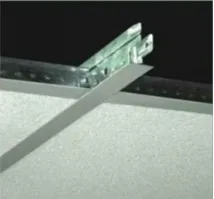- Afrikaans
- Albanian
- Amharic
- Arabic
- Armenian
- Azerbaijani
- Basque
- Belarusian
- Bengali
- Bosnian
- Bulgarian
- Catalan
- Cebuano
- Corsican
- Croatian
- Czech
- Danish
- Dutch
- English
- Esperanto
- Estonian
- French
- German
- Greek
- Hindi
- Indonesian
- irish
- Italian
- Japanese
- Korean
- Lao
- Malay
- Myanmar
- Norwegian
- Norwegian
- Polish
- Portuguese
- Romanian
- Russian
- Serbian
- Spanish
- Swedish
- Thai
- Turkish
- Ukrainian
- Uzbek
- Vietnamese
Νοέ . 25, 2024 09:51 Back to list
Comparing PVC and Gypsum Ceilings for Modern Interior Design Choices
PVC Ceiling vs. Gypsum Ceiling A Comprehensive Comparison
When it comes to interior ceiling design, homeowners and builders often face the dilemma of choosing between PVC (Polyvinyl Chloride) ceilings and gypsum ceilings. Both materials have their unique advantages and disadvantages, making the choice dependent on specific needs and preferences. In this article, we will explore the features, benefits, and drawbacks of both PVC and gypsum ceilings to help you make an informed decision.
1. Material Composition and Aesthetics
PVC ceilings are made from lightweight plastic panels that are often available in a variety of colors and textures, offering a modern and stylish appearance. They can mimic other materials, like wood or stone, making them versatile in design. Gypsum ceilings, on the other hand, are made from gypsum board, which is composed of calcined gypsum, a naturally occurring mineral. Gypsum offers a more traditional and elegant look, often preferred in formal or classic interior designs.
2. Installation Process
One of the significant advantages of PVC ceilings is their ease of installation. The lightweight panels can be easily handled and cut, allowing for a quicker installation process. They can be mounted directly onto existing ceilings or framing. Gypsum ceilings require careful installation and finishing, including taping and mudding to ensure a smooth surface. This process can be more labor-intensive, often leading to higher installation costs.
pvc vs gypsum ceiling

When it comes to durability, PVC ceilings are resistant to moisture, making them ideal for humid environments like bathrooms and kitchens. They do not warp, rot, or mold, ensuring longevity and lower maintenance requirements. In contrast, gypsum ceilings can be susceptible to water damage if exposed to moisture over time, which can lead to sagging and the need for repairs. However, gypsum ceilings can be painted and repainted, offering flexibility in changing aesthetics over time.
4. Acoustic Properties
Gypsum ceilings often have superior acoustic properties due to their density, making them effective in sound insulation. This can be particularly beneficial in multi-story buildings or shared living spaces. PVC ceilings, while they can provide some sound damping, may not offer the same level of sound insulation as gypsum.
5. Cost Considerations
PVC ceilings are generally more affordable than gypsum ceilings. The lower material cost combined with easier installation can make PVC a more budget-friendly option. However, it is essential to factor in the long-term benefits, as the durability of PVC can translate into savings over time.
Conclusion
In conclusion, both PVC and gypsum ceilings have their merits. If you prioritize ease of installation, moisture resistance, and a modern aesthetic, PVC may be the right choice for you. On the other hand, if you desire a classic look with superior sound insulation and are willing to invest in installation and maintenance, gypsum could be the better option. Ultimately, your decision should align with your specific needs, budget, and design preferences.
-
PVC Laminated Gypsum Ceiling Board OverviewNewsApr.11,2025
-
Mineral Fiber Ceiling Tiles Price Analysis and ComparisonsNewsApr.11,2025
-
Crafts of Mineral Fiber Ceiling Tile ManufacturingNewsApr.11,2025
-
Difference Between Gypsum and PVC CeilingNewsApr.11,2025
-
An Overview of Mineral Fiber Ceiling TilesNewsApr.11,2025
-
Advantages of PVC Gypsum CeilingNewsApr.08,2025







